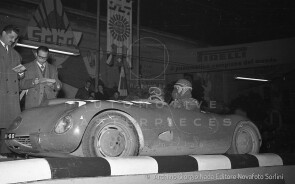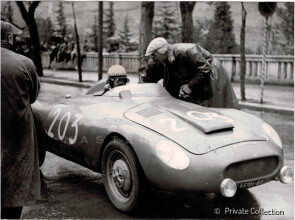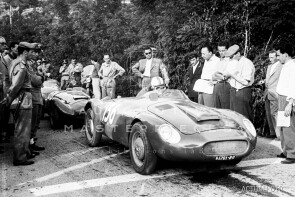
1954 Panhard Dyna X86 Spider
ON/OFF
Why am I an Automotive Masterpiece?
The Panhard Dyna X was a subcompact car produced by the French manufacturer Panhard from 1948 to 1953. It holds the distinction of being the first mass-produced car with an all-aluminum body. In 1943, engineer Jean-Albert Grégoire presented a car that incorporated many of the technical principles of the Amilcar Compound (notably its chassis and suspension). The project was initiated by Aluminium Français to promote the use of aluminum in automotive construction, but initially failed to attract the interest of manufacturers. However, under the framework of the “Plan Pons,” Panhard reached an agreement with Grégoire to continue development of the AFG prototype (Aluminium Français – Grégoire), providing the mechanical components. The result was the Dyna, featuring an aluminum body on a steel frame, an air-cooled 610 cc aluminum flat-twin engine, a four-speed gearbox, independent suspension on all four wheels (coil springs in front and torsion bars at the rear), and—most notably—front-wheel drive. The Dyna was first shown at the 1946 Paris Motor Show, and production began in October 1947, with bodywork subcontracted to Facel-Métallon (later known for producing the luxurious Facel Vega). From 1948, the car was sold as the Dyna X type 100 (X84), with only minimal changes from the 1946 prototype. The name referenced its top speed of 100 km/h. In 1950, the model gained a new grille with a central circular motif, and the type 110 (X85) replaced the 100. The 610 cc engine (classified as 3 CV) was upgraded from 22 to 28 hp (SAE). In April 1950, a new 745 cc engine (4 CV) producing 32–34 hp was introduced in the type 120 (X86). In February 1952, an optional Sprint version of the 4 CV engine offered 36–37 hp, thanks to a revised camshaft and a twin-barrel carburetor. In April, a roadster derivative named Dyna X Junior was launched. In June, the type 130 (X87) received a more powerful 5 CV / 851 cc engine, while the older types 110 and 120 were discontinued in December. For the 1953 model year, the type 130 could reach a top speed of 130 km/h when fitted with the Sprint 5 CV / 40 hp engine. The Dyna X was a surprisingly spacious vehicle for its class: at 3.82 meters long, it approached the dimensions of higher-segment cars, though its modest engine placed it in direct competition with models like the Renault 4CV, one of its main rivals. The Dyna X was available as a saloon, convertible, and station wagon, with a van version (Dyna K) also produced. Its design was decidedly unconventional, with a rounded body and protruding front headlights. Although the public was initially skeptical due to its unusual styling, the car eventually gained popularity for its agile handling and fuel economy. Performance was also commendable for the time. Built on a tubular chassis, the Dyna X’s aluminum alloy body kept its weight low, enhancing road performance. The model inspired many sporting interpretations, with coachbuilders creating aerodynamic sports cars, both open and closed. The Dyna X was discontinued in 1953 and replaced by the Panhard Dyna Z.
The car with chassis no. 481821 was built in 1954 on a Panhard Junior X86 chassis, with expressly tuned engine, with bodywork handcrafted in the Modena area with a light aluminum "skin" (F.lli Rimondi) sitting on a frame of light tubes (Zucchelli) in a 2-seater "barchetta" type, with the lines that, especially in the front, initially had an aerodynamic shape and somehow Panhard appeal, with a third central headlight. After the first racing season, in 1955 the nose received a larger and more classic air intake with a design reminiscent of the Ferrari styles of the time. It was sold new by Gastone Crepaldi, not only a well-known Ferrari dealer, but head of the Ital-France team, responsible for the Panhard competitive effort in Italy and, at that time, official importer of Panhard cars in Italy. The car participated with its first owner, Adriano Zerbini of Bologna, in the last four editions of the Mille Miglia speed race, in 1954, 1955, 1956 and 1957. In 1954 it ranked 8th in class and 125th overall. The car had a noteworthy racing career with the first owner who drove it in some of the most important races on the Italian territory of those years, such as the Trofeo Supercortemaggiore, the Corsa in salita sulle Torricelle, the Coppa della Consuma among others events. Sold in 1957, it had 4 other passionate owners, before arriving, in 1982, in the hands of the last owner who has kept it, therefore, for 39 years. The chassis car no. 481821 is still registered with its original Bologna plate from 1954. Initially and perfectly restored by Mario Galbiati, using all the original parts, the car undertook a second exciting career since 1986 in re-enactment races for vintage cars, such as the Coppa d'Oro delle Dolomiti and the Stella Alpina, ranking 1st overall at the Coppa dei Due Mari in Riccione. In 1992 it participated in the historic Mille Miglia with a very good result: 5th overall and 4th in class C. In 1993 it was involved in an accident while facing the Mille Miglia, which led to a deep restoration: what was unrecoverable was rebuilt, everything else was kept; the chassis number, still present, has not been compromised. Restored by the F.lli Lopane, with digitization of the Politecnico di Milano and mechanics cared by the specialist Cesare in Valenza, the car has found its place in the circuit of the most important vintage car events. It is fitted with an 850 cc engine tuned for the period races but a conforming to the original disassembled engine (no. S3 *021335*) is also present. The car is published in the book "MILLE MIGLIA'S CHASSIS The Ultimate Opus Volume II".






